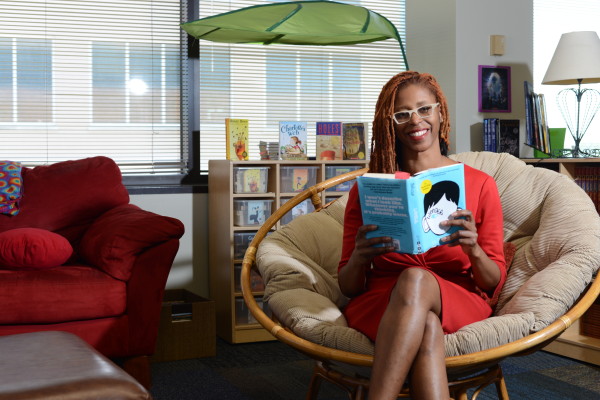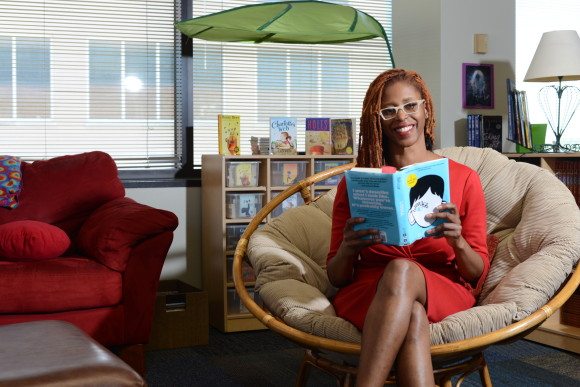
Photo by Arthur Smith
PEOPLE WHO INSPIRE: RHONDA BROUSSARD
Seeing that level, of engagement for our kids, that’s what, wakes me up in the morning. If we as adults can unlock this potential for our students and give them this space to create, and then get out of the way, they can change the world way faster than we can.”
Rhonda Broussard, the founder of St. Louis Language Immersion Schools, has been a lifelong educator, and says that watching students learn and really uncover their own questions and their own action is what inspires her most on a daily basis. Having taught French in public schools in New York City, Connecticut, California, and St. Louis along with raising her own children bilingually, Broussard is the ideal advocate for immersion school programs and the benefits of incorporating foreign language into a child’s early growth and development.
Broussard has earned National Board Certification, the most prestigious teaching credential in the United States as well as completing her undergraduate studies in French and Secondary Education at Washington University in St. Louis and a Master of Arts degree in French Studies from New York University’s Institute of French Studies.
Children start their mornings in the immersion schools with their teacher greeting them in French, Spanish or Mandarin Chinese. While a typical schedule is followed for the children, including the standard classroom subjects as well as specials such as library, art, and P.E., the chosen foreign language is incorporated for all activities throughout the day. According to Broussard, students who start speaking another language in elementary school then develop a truly natural fluency in both English and their chosen language.
“Students may be in first grade in a unit of study around how people use art to express emotions. And so if that’s the question they are answering, within that unit of study they are going to be learning the elements of a story, and they’ll be learning all the art vocabulary, exposure to authors and dancers, painters, musicians, who will come in and display their particular art” Said Broussard.
Broussard says this process gets you inspired as a learner first before you are given information and answers. Students can ask their own questions about the work and not simply be solving what the teacher’s questions were. Students are give the time to explore a topic on their own as well as provocation from their teacher, who enables them to see what they can create.
Students in the immersion programs are able to speak on academic impacts and social impacts, because they have done research in two languages and are really comfortable presenting that information back out. Students become more agile speakers and understand early on that there is more than one way that you can say something. This means there are multiple viewpoints that are developing when children are exposed to a different language and the obstacles that go along with it.
“Students in the classroom know that if a teacher phrases something and they are not understanding that they can ask for help or try multiple times. We see those non-cognitive skills transfer into their work in general. They tend to be more resilient and more creative problem solvers because they have been making meaning from language works and context throughout their academic career” Said Broussard.
The school’s fifth graders are assigned projects in which they must think about something they have deep personal passion for, and then they identify a problem and a need within that passion area. They then think about what they can do as an 11 year old to address it. Keep in mind this process is tackled in a foreign language.
“I am hopeful for the world when I hear them because they are tackling some really big questions and when you listen to them talk through the process they articulate what struggles they had in their research and work and fears they had to overcome” Said Broussard.
The immersion schools are intentionally diverse. With students from all different ethnic groups, all types of family compositions, and socioeconomic diversity, both children and parents are making relationships with people that they may not have had the opportunity to meet before.
“[As a result] our adult community has grown much more sensitive and welcoming to people from all walks of life and have made closer ties to our current students and everyone who has been touched by the St. Louis Language Immersion Schools” Said Broussard.
words by Hannah Sundermeyer
- Aziel Jackson – In His Own Words: Making His “FIRST MOVE” in Fashion - Thursday, March 14, 2024
- Miami Dolphins’ Stand-Out Terron Armstead Continues To Win In The Art of Giving-Back - Monday, June 5, 2023
- Delux Feature: Celebrity Barber and Fitness Trainer, Lawrence Roebuck, Shares His Tips for a Healthier Lifestyle During Stress Awareness Month - Monday, May 8, 2023








